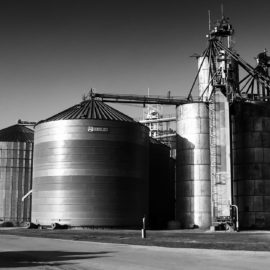
Whitney Plantation has voiced opposition to the grain terminal slated to e built close to the museum.
The board of directors running the Whitney Plantation announced its opposition to a $400 million, 56-silo grain terminal planned less than a mile from its museum Monday, citing concerns over air pollution and calling the project “unlawful.” “It is our belief that the project as presented is unlawful, and should not be granted either a Coastal Use Permit or U.S. Army Corps of Engineers permits,” wrote the Whitney Institute’s seven-member board in a statement. The plantation’s announcement comes in the wake of calls from environmental advocates and some local residents for the Greenfield Exports LLC — the company backing the project — to build elsewhere. Meanwhile, local and state officials, including Gov. John Bel Edwards, have signed letters in support of the project, and company officials have said it will be one of the cleanest facilities in North America. On Monday, Greenfield representatives argued the statement reflects the desire of the museum’s founder, John Cummings, to own the property that the terminal would sit on, saying the announcement goes against the retired lawyer’s past promises to company officials that the plantation was in support. “We trust our neighbors will see Mr. Cummings’ recent maneuvers for what they are: a cynical attempt to shut down a project that will benefit the community,” said a Greenfield representative.
nola.com
Whitney Plantation is a big house plantation but focuses on the slave experience rather than the white owners luxurious life.
Cummings opened the plantation in 2014, looking to use the museum’s 40 acres to educate visitors on the lives of those once enslaved on the property. In 2019, the founder donated the museum to the nonprofit, The Whitney Institute, to be governed by a board. His wife, Donna, still chairs it. “He has not been representing the plantation since December of 2019,” Donna Cummings said of her husband Monday, adding that he isn’t involved in board decisions. She said the statement was developed over the course of several board meetings and ultimately received unanimous approval. John Cummings said he has no interest in purchasing the property, which he gave up his stake in decades ago, and has yet to see the board’s statement. “It’s insulting,” he said, noting the board of directors is majority Black. “These people are coming into an African-American community, and they’re suggesting that I’m somehow a puppeteer.”
The gran elevator is expected to bring jobs to the area as well as pollute the air more than it is now.
Expected to hold as much as 8 million metric tons of grain, Greenfield’s elevator would provide 100 jobs paying an average of $75,000 a year, plus 500 “indirect jobs,” the company said. The terminal’s 248-acre site sits just a few hundred feet from the doorsteps of residents living in the mostly Black community of Wallace, where many of whom descended from those once enslaved at Whitney. This includes the plantation’s communications director, Joy Banner, who runs a separate nonprofit that is suing the parish in attempt to overturn the site’s industrial zoning designation and has led the group of residents opposing the terminal. Recognized by the National Register of Historic Places, the Whitney Plantation sits on an 18-mile stretch of St. John the Baptist’s west bank that is one of the few areas along the Mississippi River that has attracted few new industrial facilities. The board argued that allowing the construction of towers “as tall as the Statue of Liberty” would impinge on the nonprofit’s mission. State and federal agencies takes impacts to historic places into consideration when issuing permits. “The viewshed of the plantation – uninterrupted miles of sugarcane fields – show visitors in a visceral way the immense pain of sugar plantation labor,” the board said. “Whitney Plantation is one of very few plantations in the state where this original viewshed as yet remains undisturbed. The construction of the grain terminal would permanently change this and forever destroy this cultural landscape.” The grain elevator has also been permitted to release as much as 37 tons of fine particulate matter, measuring as large as 2.5 micrometers per year, and emitting 81 tons of particulate matter, measuring as large as 10 micrometers per year. The board worried the odors, dust and noise could harm the number of visitors it receives and noted the health risks to local residents from grain dust, potentially leading to respiratory issues.
At the resent, the land is farm land and the thought is that unmarked graves might be found there.
Currently, the site is largely farmland, and Whitney’s board members said the land might contain unmarked burial grounds as well as historical artifacts that could be destroyed by development. Greenfield representatives have strongly denied the existence of graveyards on the site, noting that past surveys haven’t identified any cultural resources that would be affected. “We are committed to taking the appropriate actions if anything is identified but to date, nothing has been identified,” the company said.
Whitney Plantation is taking a stand for the people it represents.



